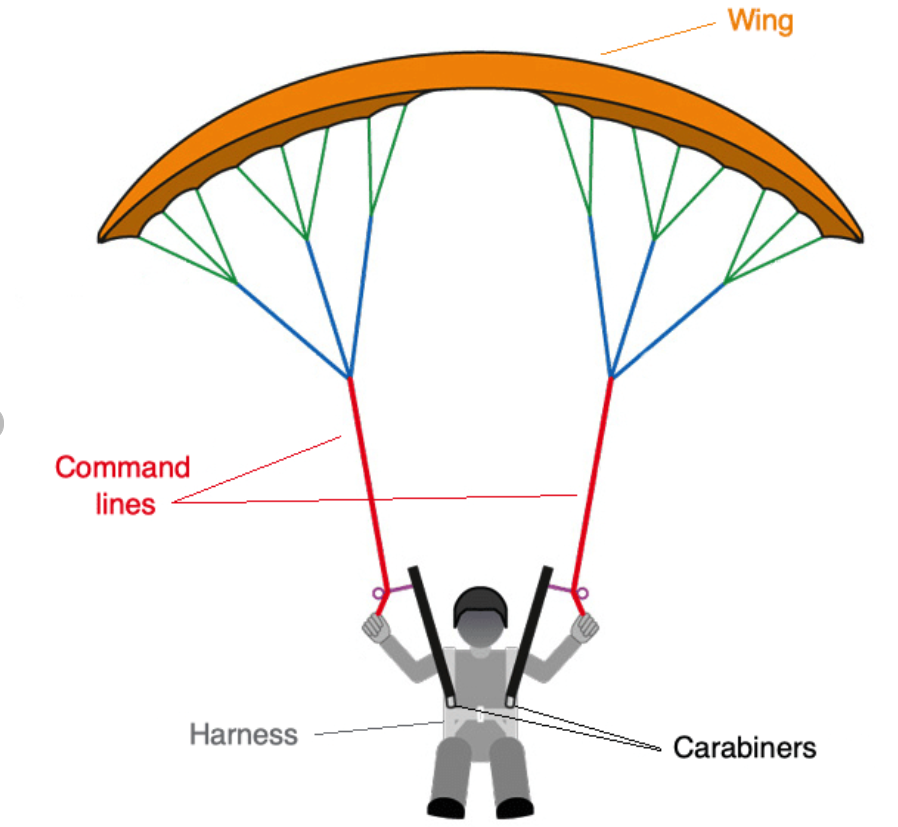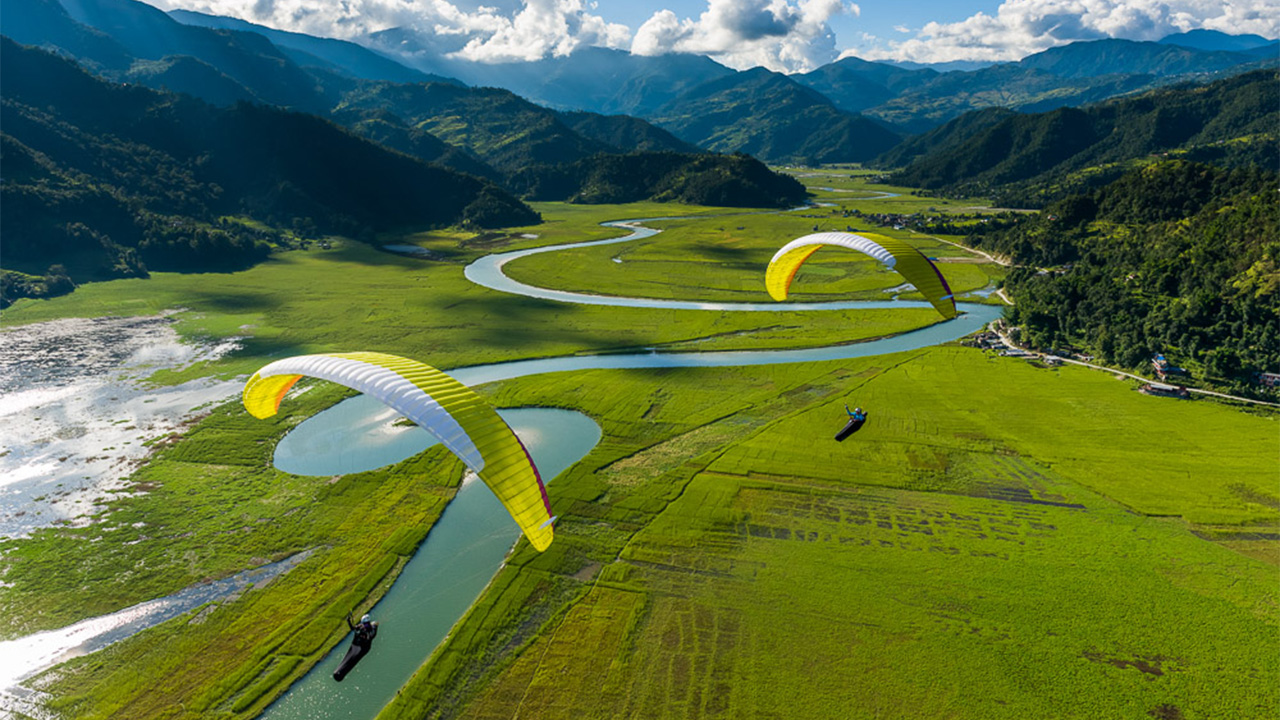Science & Technology
The Civil Aviation Authority of Nepal (CAAN) has suspended all paragliding activities indefinitely across the country in the wake of the pilot's death at the National Games in Pokhara.
As Nepal remains black-listed by the European Union, CAAN seems to be taking extra caution regarding air safety, pinning hopes that the Europeans will lift the ban.
But why did the paraglider fall, and what steps is CAAN taking to make it safer?
To understand why paragliders fail, we need to know how paragliders fly.
How does a paraglider fly?
A paraglider is simply a parachute (glider) launched and landed without needing a runway or ground-based infrastructure.
Paragliders sometimes come with engines attached. But that is not the case in Nepal. Instead, they rely on the forces of gravity and aerodynamics to keep them afloat.

The rectangular fabric wing has cells (a tunnel-like structure between two layers of fabric) where air can pass through. The air that passes generates lift (upthrust), the mechanics behind which is very similar to an airplane.
The amount of lift depends on the speed of the air around the wing and air density. Therefore, to produce more lift, the object must speed up and/or increase the wing's angle of attack (by pushing the aircraft's tail downwards).
When the wing is perfectly horizontal, the lift is maximum, whereas when the wing gets turned, the lift decreases. Some lifts are also generated by the air flowing upward from the ground, generally called thermal. The thermal is quite essential for achieving greater heights in paragliding.
Why do accidents happen?
Looking at past accidents in Nepal, some of which are caused by carelessness, like loosely tied harnesses and dangerous aerobatic manoeuvres on low altitudes. But many of those incidents related to losing control of the glider amid flight.
The loss of control can be attributed to various reasons: Some common causes are:
• Flying in strong winds
A paraglider is a very light flying craft that uses aerodynamic forces (force from the air) to fly. When these gliders face gusts of wind (turbulence), keeping the glider under control becomes difficult. Thus, the pilot loses control of the paraglider and met with an accident.
While the investigation is going on, preliminary reports and witness reports suggest Nisim Thapa encountered strong wind that folded one side of his glider called collapsing. As a result, the craft spiralled out of control, fell from 100 metres, and slammed into the ground.
Sunil Bhattarai, the owner of Sunrise Paragliding, who is also a paraglider pilot, said: "If he had height, he could have recovered from downward spiralling. Sadly, he had just taken off and was around hundred metres above the ground."
• Flying too close to trees or other obstacles
Flying close to trees or other obstacles is very dangerous, considering the little time the pilot has to regain control of the craft. Besides, the speed and force you may use to hit the ground can be deadly.
In 2020, a pilot was killed, and the passenger was injured as the paraglider hit a tree during a tandem flight (double flight) after they bled altitude to aerobatics.
• Dangerous aerobatics
Aerobatics can be fun and can hike your adrenaline, but it has equal chances of failure.
First, if not done correctly, aerobatics can stress the glider and the pilot, leading to a crash.
Second, unless done carefully, aerobatics can disorient the pilot and cause them to lose control of the glider. And aerobatics can be dangerous to the pilot and any bystanders if not done in a safe area.
While doing aerobatics, the lift may decrease and not be enough to stay afloat. As a result, it causes a sudden drop in altitude and can be deadly when the craft slams into the terrain.
• Need for speed
As discussed in paragliding mechanics, speed is proportional to upthrust. So, not having enough upthrust means the glider stalls can lose altitude. It isn't easy to recover a stalling paraglider without sufficient height. Balancing speed and altitude are keys to controlling the glider.
What's next?

CAAN, which has put a blanket ban on paragliding activities across the country, said it is "investigating the accident". However, this ban will not be lengthy to disrupt the tourism industry.
Gyanendra Bhul, deputy manager and information officer at CAAN, said: "We are not discouraging the paragliding industry. On the contrary, we are trying to review the regulations and permissions given to the industry to make it safer."
CAAN has formed a committee, including the owners of paragliding companies, that will investigate the incident and make a report to suggest that CAAN update the regulations.
"This should take no more than a few days," he added.
Accidents like these will diminish chances for lifting the EU ban, said Bhul, adding, "We understand the EU is on the verge of lifting the ban. So, we don't want to ruin our improved air safety record."
According to Bhul, accidents in the air, unlike those on the road, are most often "attributed to pilots or safety protocols [not technical failures and natural causes]."
Critics argue that a blanket ban is unscientific and illogical that can disrupt the adventure sports industry.
Sunrise Paragliding started commercial paragliding in Nepal in 1996. The first fatal accident in Nepal's paragliding history happened in 2010. Seventeen people have been killed in paragliding accidents over the past 26 years.
"We were recovering after two years of Covid-19 slowdown, and now we face this challenge," said Bhattarai, the owner of Sunrise Paragliding and chairperson of Nepal Airsports Association. These days, we were doing 300 to 400 flights a day, nearly three times more than average. But the blanket ban has shattered our hopes."
Bhattarai, who is in Kathmandu for a meeting with CAAN officials, added: "Not all accidents are caused by human carelessness or error; this is one of them. So, we don't expect ban to extend longer."
Also Read: Pilot's death leaves paragliding event in uncertainty
Also Read: Paragliding to start in Phulchoki and Panauti
Watch embedded video via Fly With Greg's YouTube Channel.






